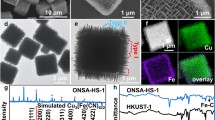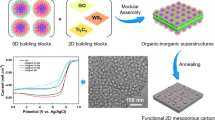Abstract
The rational assembly of ultrathin films of metal–organic frameworks (MOFs)—highly ordered microporous materials1,2,3,4,5—with well-controlled growth direction and film thickness is a critical and as yet unrealized issue for enabling the use of MOFs in nanotechnological devices, such as sensors, catalysts and electrodes for fuel cells. Here we report the facile bottom-up fabrication at ambient temperature of such a perfect preferentially oriented MOF nanofilm on a solid surface (NAFS-1), consisting of metalloporphyrin building units. The construction of NAFS-1 was achieved by the unconventional integration in a modular fashion of a layer-by-layer growth technique coupled with the Langmuir–Blodgett method. NAFS-1 is endowed with highly crystalline order both in the out-of-plane and in-plane orientations to the substrate, as demonstrated by synchrotron X-ray surface crystallography. The proposed structural model incorporates metal-coordinated pyridine molecules projected from the two-dimensional sheets that allow each further layer to dock in a highly ordered interdigitated manner in the growth of NAFS-1. We expect that the versatility of the solution-based growth strategy presented here will allow the fabrication of various well-ordered MOF nanofilms, opening the way for their use in a range of important applications.
This is a preview of subscription content, access via your institution
Access options
Subscribe to this journal
Receive 12 print issues and online access
$259.00 per year
only $21.58 per issue
Buy this article
- Purchase on Springer Link
- Instant access to full article PDF
Prices may be subject to local taxes which are calculated during checkout




Similar content being viewed by others
References
Yaghi, O. M. et al. Reticular synthesis and the design of new materials. Nature 423, 705–714 (2003).
Férey, G. Hybrid porous solids: Past, present, future. Chem. Soc. Rev. 37, 191–214 (2008).
Seo, J. S. et al. A homochiral metal–organic porous material for enantioselective separation and catalysis. Nature 404, 982–986 (2000).
Kitagawa, S., Kitaura, R. & Noro, S. Functional porous coordination polymers. Angew. Chem. Int. Ed. 43, 2334–2375 (2004).
Li, Q. et al. Docking in metal–organic frameworks. Science 325, 855–859 (2009).
Sheldon, R. A. Metalloporphyrins in Catalytic Oxidations (Marcel Dekker, 1994).
Abrahams, B. F., Hoskins, B. F., Michail, D. M. & Robson, R. Assembly of porphyrin building blocks into network structures with large channels. Nature 369, 727–729 (1994).
Goldberg, I. Crystal engineering of porphyrin framework solids. Chem. Commun. 1243–1254 (2005).
Choi, E. Y. et al. Pillared porphyrin homologous series: Intergrowth metal–organic frameworks. Inorg. Chem. 48, 426–428 (2009).
Kosal, M. E., Chou, J. H., Wilson, S. R. & Suslick, K. S. A functional zeolite analogue assembled from metalloporphyrins. Nature Mater. 1, 118–121 (2002).
Suslick, K. S. et al. Microporous porphyrin solids. Acc. Chem. Res. 38, 283–291 (2005).
Shultz, A. M., Farha, O. K., Hupp, J. T. & Nguyen, S. T. A catalytically active, permanently microporous MOF with metalloporphyrin struts. J. Am. Chem. Soc. 131, 4204–4205 (2009).
Zacher, D., Shekhah, O., Wöll, C. & Fischer, R. A. Thin films of metal–organic frameworks. Chem. Soc. Rev. 38, 1418–1429 (2009).
Choi, M. et al. Stable single-unit-cell nanosheets of zeolite MFI as active and long-lived catalysts. Nature 461, 246–250 (2009).
Theobald, J. A., Oxtoby, N. S., Phillips, M. A., Champness, N. R. & Beton, P. H. Controlling molecular deposition and layer structure with supra molecular surface assemblies. Nature 424, 1029–1031 (2003).
Stepanow, S. et al. Steering molecular organization and host–guest interactions using two-dimensional nanoporous coordination systems. Nature Mater. 3, 229–233 (2004).
Madueno, R., Raisanen, M. T., Silien, C. & Buck, M. Functionalizing hydrogen-bonded surface networks with self-assembled monolayers. Nature 454, 618–621 (2008).
Grill, L. et al. Nano-architectures by covalent assembly of molecular building blocks. Nature Nanotech. 2, 687–691 (2007).
Hermes, S., Schroder, F., Chelmowski, R., Wöll, C. & Fischer, R. A. Selective nucleation and growth of metal–organic open framework thin films on patterned COOH/CF3-terminated self-assembled monolayers on Au(111). J. Am. Chem. Soc. 127, 13744–13745 (2005).
Biemmi, E., Scherb, C. & Bein, T. Oriented growth of the metal organic framework Cu3(BTC)2(H2O)3·xH2O tunable with functionalized self-assembled monolayers. J. Am. Chem. Soc. 129, 8054–8055 (2007).
Scherb, C., Schödel, A. & Bein, T. Directing the structure of metal–organic frameworks by oriented surface growth on an organic monolayer. Angew. Chem. Int. Ed. 57, 5777–5779 (2008).
Shekhah, O. et al. Step-by-step route for the synthesis of metal organic frameworks. J. Am. Chem. Soc. 129, 15118–15119 (2007).
Shekhah, O. et al. Controlling interpenetration in metal–organic frameworks by liquid-phase epitaxy. Nature Mater. 8, 481–484 (2009).
Yang, H. C. et al. Growth and characterization of metal(II) alkanebisphosphonate multilayer thin films on gold surfaces. J. Am. Chem. Soc. 115, 11855–11862 (1993).
Kanaizuka, K. et al. Construction of highly oriented crystalline surface coordination polymers composed of copper dithiooxamide complexes. J. Am. Chem. Soc. 130, 15778–15779 (2008).
Ito, Y. et al. Crystalline ultrasmooth self-assembled monolayers of alkylsilanes for organic field-effect transistors. J. Am. Chem. Soc. 131, 9396–9404 (2009).
Töllner, K., Biro, R. P., Lahav, M. & Milstein, D. Impact of molecular order in Langmuir–Blodgett films on catalysis. Science 278, 2100–2102 (1997).
Takamoto, D. Y. et al. Stable ordering in Langmuir–Blodgett films. Science 293, 1292–1295 (2001).
Qian, D. J., Nakamura, C. & Miyake, J. Multiporphyrin array from interfacial metal-mediated assembly and its Langmuir–Blodgett films. Langmuir 16, 9615–9619 (2000).
Qian, D. J., Nakamura, C. & Miyake, J. Layer-by-layer assembly of metal mediated multiporphyrin arrays. Chem. Commun. 2312–2313 (2001).
Acknowledgements
We thank JST (CREST), NEDO and JSPS (No. 20350030 and 20655030) and the Global COE Program ‘Science for Future Molecular Systems’ for financial support, SPring-8 for access to the synchrotron X-ray facilities under the Priority Nanotechnology Support Program administered by JASRI (2008B1801, 2009A1703) and under proposal 2008B2205 and the Center of Advanced Instrumental Analysis, Kyushu University for the use of the FT-IR spectrometer and the ESCA system.
Author information
Authors and Affiliations
Contributions
This work has been carried out mainly by JST-CREST and METI-NEDO projects where H.K. is a project leader and responsible for all. R.M. designed this study, interpreted the results and carried out sample preparation, XPS, infrared and AFM characterization and structural model construction. R.M. and Y.U. carried out Langmuir–Blodgett film fabrication and absorption spectra measurements. O.S. was responsible for supervising the synchrotron XRD measurements. R.M. carried out the synchrotron XRD measurements with the help of S.M. and H.Y. All authors commented on the manuscript. R.M and H.K. were responsible for writing the manuscript.
Corresponding authors
Ethics declarations
Competing interests
The authors declare no competing financial interests.
Supplementary information
Supplementary information
Supplementary Fig. S1-S10 (PDF 3255 kb)
Rights and permissions
About this article
Cite this article
Makiura, R., Motoyama, S., Umemura, Y. et al. Surface nano-architecture of a metal–organic framework. Nature Mater 9, 565–571 (2010). https://doi.org/10.1038/nmat2769
Received:
Accepted:
Published:
Issue Date:
DOI: https://doi.org/10.1038/nmat2769
This article is cited by
-
Mechanistic insights into the deformation and degradation of a 2D metal organic framework
npj 2D Materials and Applications (2023)
-
A Bis(terpyridine)nickel(II)-Based Coordination Nanosheet: A Redox-Active Material with Flexibility and Transparency
Journal of Inorganic and Organometallic Polymers and Materials (2023)
-
Synthesis of new hybrid indolyl-pyridines with sulfonamide moiety in the presence of Fe3O4@SiO2@(CH2)3-urea-quinolinium trifluoroacetate via a cooperative vinylogous anomeric-based oxidation
Journal of the Iranian Chemical Society (2023)
-
Cathode materials for lithium-sulfur battery: a review
Journal of Solid State Electrochemistry (2023)
-
Metal-organic layers: Preparation and applications
Science China Materials (2023)



